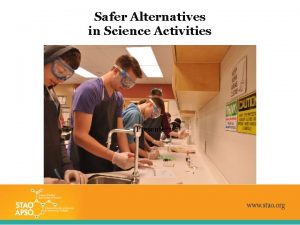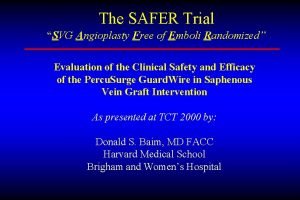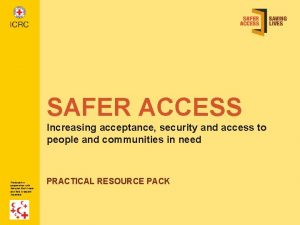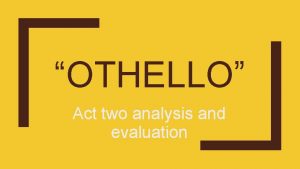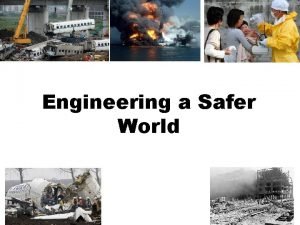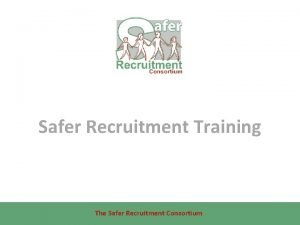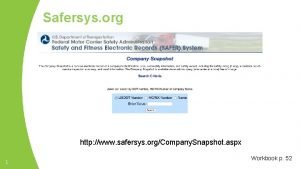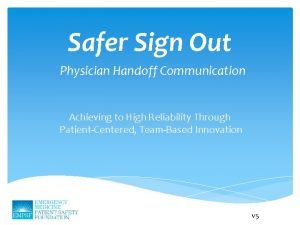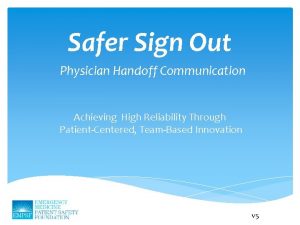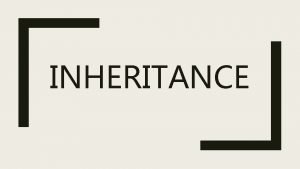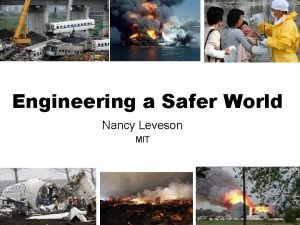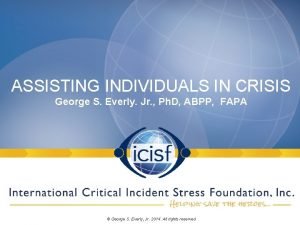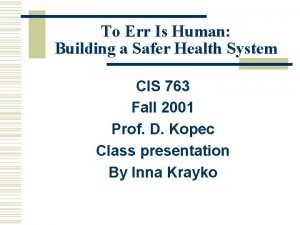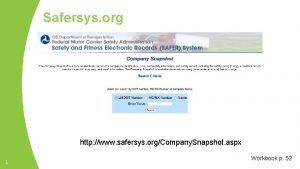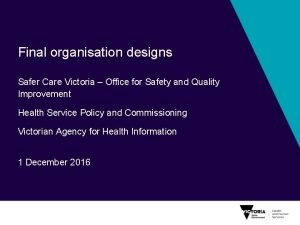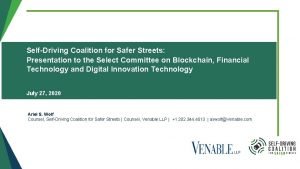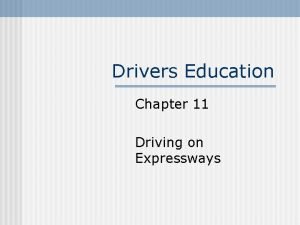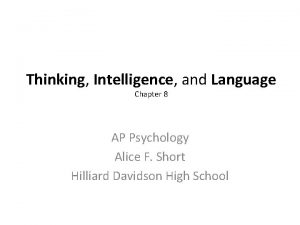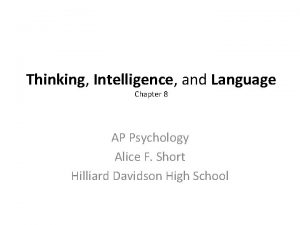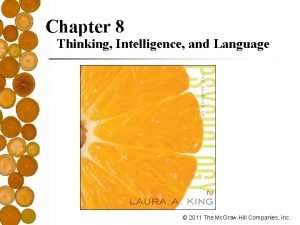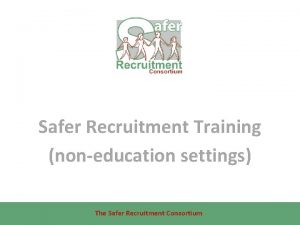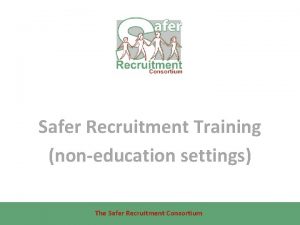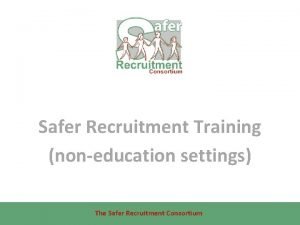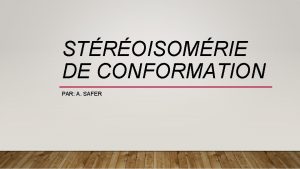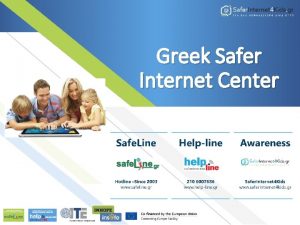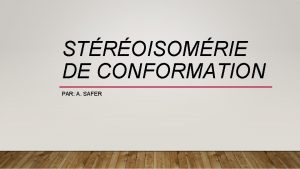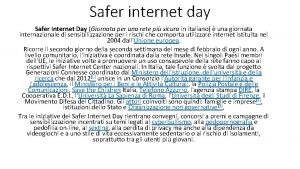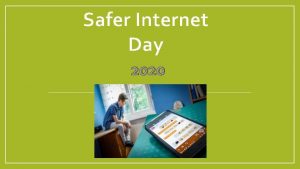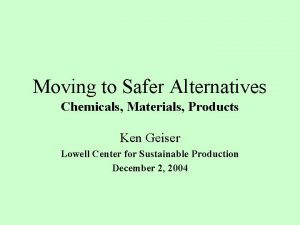Safer Alternatives in Science Activities Presenter Activities and





























- Slides: 29

Safer Alternatives in Science Activities Presenter:

Activities and Science Education • Hands-on activities are an integral part of science education • Carefully selected lab activities can be safe and still have a considerable “wow” factor

Science Can be Fun and Safe It takes: • Planning (for both the expected and unexpected) • Common sense • On-going training

Safe “Wow” Factor in Science

Teacher Roles and Responsibilities ‘Teachers are also responsible for ensuring the safety of students during classroom activities and for encouraging and motivating students to assume responsibility for their own safety and the safety of others. They must also ensure that students acquire the knowledge and skills needed for safe participation in science activities. ” The Ontario Curriculum Grades 11 and 12, Science, 2008, p. 8

Safety in the Curriculum Expectations Expectation A 1. 4 Apply knowledge and understanding of safe laboratory practices and procedures when planning investigations by correctly interpreting (WHMIS) symbols; by using appropriate techniques for handling and storing laboratory equipment and materials and disposing of laboratory materials; and by using appropriate personal protection (e. g. , wearing safety goggles).

Plan for Safety

Reduce Quantities • Large quantities – Expensive – Storage and disposal concerns • Microscale quantities – Minimal cost, storage and disposal concerns – Saves time (once prepped)

Gas Explosions

Reduce Quantities e. g. , microscale procedures Mg(s) + 2 HCl(aq) → H 2(g) + Mg. Cl 2(aq)

Alkali Metals

Safer Alternative

Elephant Toothpaste

Reduce Concentration

Choosing Safer Chemicals Useful tools: • Board chemical lists • WHMIS 2015 & SDS • NPFA or HMIS rating system (given on some MSDS and SDS)

Safer Alternatives: Chemicals and WHMIS 2015

Safer Alternatives: Chemicals Avoid highly toxic compounds, e. g. , Precipitation of lead(II) iodide demo Lead(II) nitrate SDS Data includes: • Reproductive Toxicity, Category 1 A. May damage fertility or the unborn child. • Carcinogenicity (Category 1 B). May cause cancer. • Acute toxicity, oral and inhalation (Category 4).

Safer Alternatives: Chemicals Safer alternative: reaction of Fe. Cl 3(aq) and Na. OH(aq) Precipitation of iron(III) hydroxide demo Iron(III) chloride SDS data includes: • Serious Eye Damage — Category 1. • Skin Irritation — Category 2. • Acute Toxicity (Oral) — Category 4.

Other Hazard Classification Systems e. g. , lead(II) nitrate NFPA HMIS WHMIS 2015 Category 1 A Most hazardous (4) Most hazardous (1)

Safer Alternatives: Dissections Preserved Specimens: • Use a reliable, board-approved vendor • Use appropriate PPE (e. g. , apron, disposable gloves, and goggles) • Follow board-approved disposal procedures (consult supplier)

Safer Alternatives: Dissections Fresh Specimens: • May be purchased from a butcher since they are from animals inspected and deemed fit for human consumption (e. g. , heart, kidney) • Take precautions to protect against microorganisms • No organisms of unknown origin (e. g. , road kill)

Safer Alternatives: Dissections The Importance of Student Preparation

Safer Alternatives: Cultures • Do not grow cultures of spores collected from environmental surfaces, e. g. , telephones, door knobs, and washrooms, etc. • Use Risk Group 1 (RG 1) organisms – low risk and unlikely to cause disease – e. g. , yeasts, some E. coli strains

Safer Alternatives: Cultures Keyboards 'dirtier than a toilet' • “Out of 33 keyboards swabbed, four were regarded as a potential health hazard and one harboured five times more germs than one of the office's toilet seats. ” • One “had 150 times the recommended limit for bacteria five times as filthy as a lavatory seat” http: //www. bbc. co. uk/news/magazine-20324304

Safer Alternatives: Cultures • Lab coats/aprons, gloves, safety glasses must be worn • Securely close all containers in which microorganisms are grown (tape) • Disinfect all surfaces with 10% bleach or board-approved solution • Date all cultures and dispose of them ASAP

Safer Alternatives in Electricity • Students should only use low voltage power sources (e. g. , batteries, low voltage power supplies) • Do not use wall outlets and car batteries or equivalent • Sample activities using low voltage sources: energy stick video link squishy circuits video link

Battery Storage Concern • 9 V batteries can easily short, creating a heat hazard Video link

Safer Alternatives in Optics • Laser classification: class 1 - class 4 (most powerful) • Only class 1, 2, 3 R lasers should be used (power output: 5 m. W or less) • Treat all laser and pointer beams as dangerous • Avoid all colours other than red Bending Light Video Link

Stay Safe !
 Presenter alternatives
Presenter alternatives What is your favorite subject and why science
What is your favorite subject and why science Safer
Safer Safer access framework
Safer access framework I had rather have this tongue cut from my mouth othello
I had rather have this tongue cut from my mouth othello Engineering a safer world
Engineering a safer world Safer recruitment consortium
Safer recruitment consortium Maybo safer model
Maybo safer model Characteristics of expressway driving
Characteristics of expressway driving Safer snapshot fmcsa
Safer snapshot fmcsa Safer sign out
Safer sign out Safer sign out
Safer sign out Single level inheritance is safer than
Single level inheritance is safer than Engineering a safer world
Engineering a safer world Safer-r model of crisis intervention
Safer-r model of crisis intervention To err is human building a safer health system
To err is human building a safer health system Safetsys
Safetsys Safer web mc
Safer web mc It stops here safer pathway
It stops here safer pathway Safer care victoria
Safer care victoria Self-driving coalition for safer streets
Self-driving coalition for safer streets Safer places scheme
Safer places scheme Chapter 11 driving on expressways
Chapter 11 driving on expressways Types of sports indoor and outdoor
Types of sports indoor and outdoor Primary and support activities
Primary and support activities Primary activities and secondary activities
Primary activities and secondary activities Comparison and selection among alternatives
Comparison and selection among alternatives Ap psychology thinking language and intelligence
Ap psychology thinking language and intelligence Evaluating alternatives and making choices among them
Evaluating alternatives and making choices among them Evaluating alternatives and making choices among them
Evaluating alternatives and making choices among them
